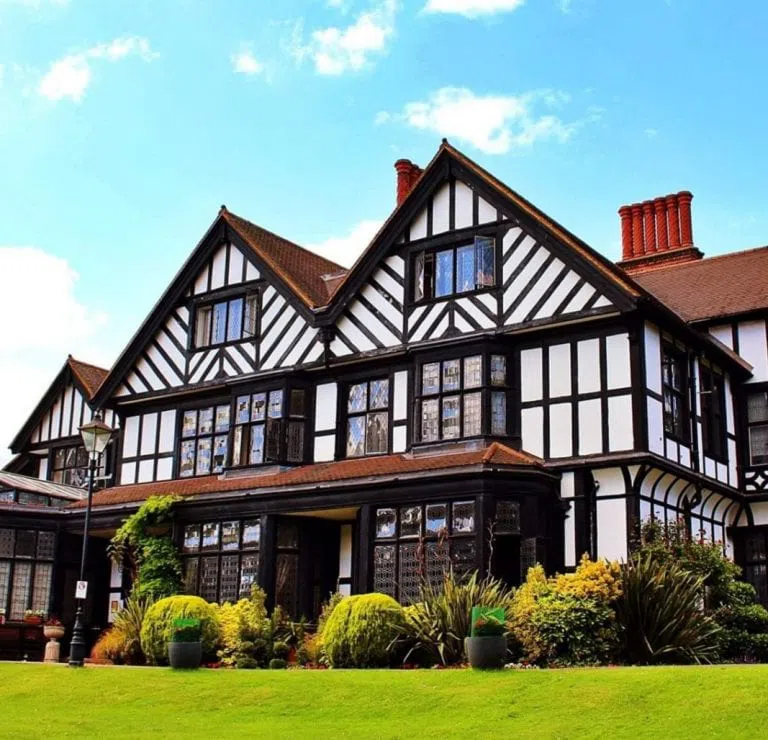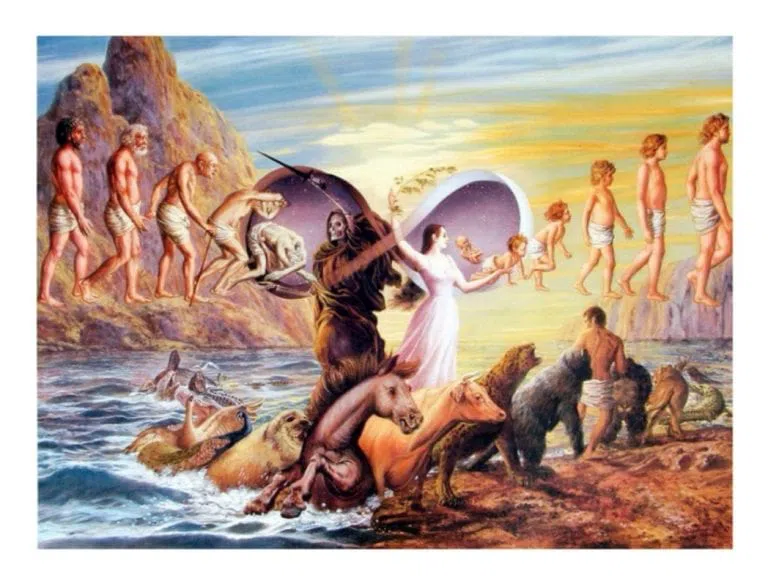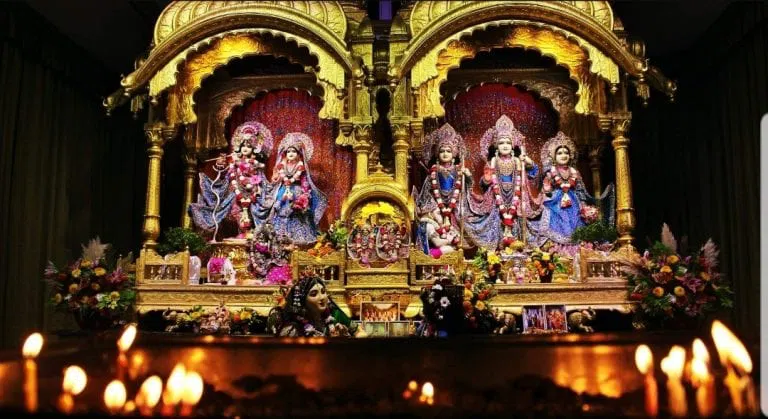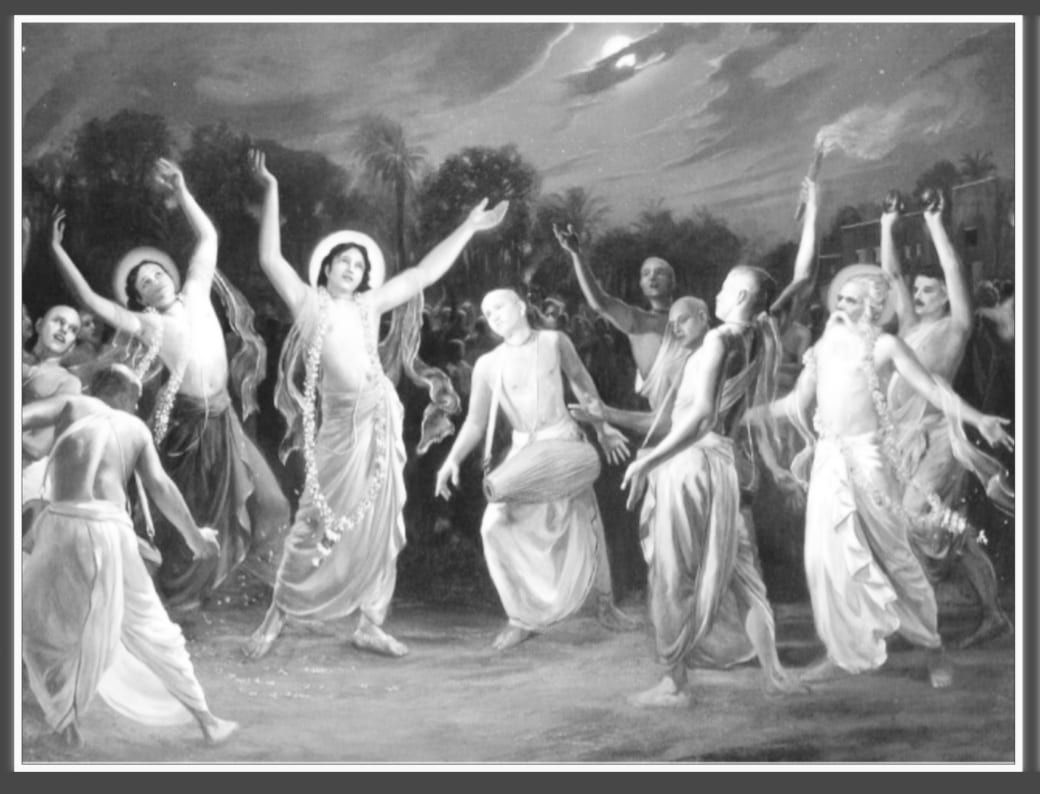Many of you commented on my last post, Swami Mā, that you felt touched by bhakti when reading it. This pleases me to no end. Feeling God’s Love, even in just a snippet of your day, is everything and more.
Swami ji always talks about bhakti (pure, divine love and devotion, or devotional service), as a prominent stream of the river of spirituality. But this notion, let alone God, never made sense to me before.
I was born in London, England, to a non-religious-Jain father with an excellent work ethic and a business mind, and an extremely gentle and kind, Hindu-Brahmin mother. The generations before me had crossed continents to find a better quality of life and to give their children a brighter future.
Somewhere along this generational journey from India to Kenya to England, the ancient wisdom and stories usually handed down by ‘grandmothers-by-candlelight’ (as I love to imagine it), were deposited in the ground and covered by the dust of material life, societal duty and the chasing of worldly dreams.
I sang biblical hymns in school, I studied Islam, Judaism, Buddhism and Western philosophy. I went to temples, churches and gurdwaras (not just for their yummy langar — free food — like some of my family members 😅). So, I suppose one could say the doorway to the spiritual discoveries and ways of thinking of others was thrown wide open. However, I always felt that something was lacking. I never really understood what those buildings were there for. What was God?
I vividly remember being around 10 or 11 years old, standing in the hallway between the living room and the front door of our house, thinking: So, we’re born, we go to school, we grow up, we get a job, we die. What’s the point of it all? (Incidentally, I walked towards the front door and not the living room. I’ve always had the tendency to head in a direction that would take me away from everything I already knew.)
I can’t remember if I asked anyone at the time, and if I did, I didn’t get any answers. Clearly, none that made sense anyway, so I was on my own.
I found part of an answer that resonated with me in a picture that I found in a book. Admittedly, I couldn’t be bothered to read the book, but the images of the paintings it held within its pages became etched in my mind forever (more on this in a bit).
One of my favourite temples to visit was (and still is) Bhaktivedanta Manor in Hertfordshire, England. It is one of the most beautiful temples of the International Society for Krishna Consciousness (ISKCON — established in the 1960’s by Srila Prabhupada). Growing up, we called this temple either the Hare Krishna Temple or simply, The Manor.

This stunning, Tudor style, English country, manor house and its grounds were donated to ISKCON by the Beatle, George Harrison. And for a few years, it was my go-to place: to be happy, to be sad, to serve, to be social, to be creative, and best of all, to jump around and sing Hare Krishna with my friends. Most temples are full of sombre people with very serious looks on their faces. We were completely the opposite; always smiling and visibly enjoying every minute of worship.
In 1993, I was thirteen, and we young, like-minded teens and twenty-somethings were brought closer together in solidarity by the threat of the closing of The Manor because of complaints from the home-owners in the nearby village about the racket coming from the temple and its surroundings, especially during festival days like Sri Krishna Janmashtami (Lord Krishna’s appearance day on Earth).
I don’t blame the villagers at all. They lived peacefully in quaint cottages in a village with a small green, a pond and a single pub, until the popularity of the temple brought a tremendous amount of traffic to their sleepy, picturesque village.
And we really were a rowdy bunch, as most Indians are. We’d toot our car horns and dance ourselves into a frenzy not just in the temple but in the grounds too; with drums beating and cymbals clashing, arms raised high in the air, jumping as high as we could and singing the Hare Krishna Maha Mantra at the tops of our voices. If I were a resident of a nearby house trying to enjoy the Sunday paper with a quiet cup of tea and a Mr. Kipling Cherry Bakewell (yummy 😊), I’d be pretty pissed off.
With the possibility of the closure of our beloved temple looming over us, many of my elder friends got together and formed a youth group. We were now the ‘Pandava Sena’ and we had a mission. Our emblem was Lord Hanuman carrying the mountain, coming to save the day. The Pandava Sena is still incredibly active today and has become an international phenomenon: http://psena.com/

We had t-shirts, caps, bandanas, banners, the lot. We sang the Lord’s name in the streets and we even organised a peaceful demonstration of thousands of people outside the Houses of Parliament, and linking arms, lay in the middle of the road, bringing central London to a standstill.
After years of campaigning, mail-outs, home visits, petitions, peaceful demonstrations and fundraising, Bhaktivedanta Manor was finally granted permission to purchase land for an access road that routed traffic away from the village.
It felt wonderful to be a part of a cause. We were united in our service to Krishna and no matter how stressful the situation, we treated each other with love and respect. If one of us was unwell or going through a difficult time, we all cared. Most of all, we had so much fun along the way! We had become a family.
My own family thought I was nuts (I think there’ll be a running theme throughout my writings that most people who knew me, totally thought I was nuts 😄 ), as even before Pandava Sena started, on most Sundays, I’d wake up at 3am, wear a simple saree, take the bus as far as I could, then join others and walk all the way down the long country road, hoping another devotee would drive by on the way to the temple and give us a lift.
Depending on whether we got a lift or not, we’d either make it in time for the Mangal Aarti which is at 4:30am or the Tulsi Pooja at 5:15am or the morning darshan from 7:15am onwards.
I wore the tilak, (the sandalwood paste mark on my forehead and nose), I had my chanting beads and bag and I was good to go. I’d chant while walking around the beautiful grounds, I’d dance around like crazy at every aarti and kirtan. I’d help in the kitchen or serve food, I’d catch up with my friends and we’d work on Pandava Sena activities like the campaign or retreats, get-togethers, games, festivals. I even made my acting debut, starring in my first dramatic production in The Manor’s theatre; a play about a cowherd friend of Krishna, who becomes lost and eventually finds his way back to Krishna (How ironic! 😊)

Surprisingly though, I didn’t bother to read the Bhagavat Gita. I never once attended the Gita discourse classes. I was a teen and having fun, I wasn’t interested in that dry, boring stuff. I didn’t really chant for any reason other than because that’s what the others were doing. I was content with what little I knew about Krishna and Lord Chaitanya Mahaprabhu from what the elder members of the Pandava Sena taught me. I heard phrases like ‘conditioned soul’, or ‘devotional service’, or ‘Supreme Personality of Godhead’ and the ISKCON magazine publication was called ‘Back to Godhead’, but I didn’t understand exactly what these things meant.
But one thing I knew for certain, I was drawn in like a magnet to Krishna, and I didn’t want to be anywhere else.
It was one day, while leafing through a book in the temple room, that I saw this painting about the cycle of samsara:

A light bulb went off in me. “Oh! So it goes round and round until we get off the ride. Well, How do I do that?” Re-birth and reincarnation absolutely made sense to me; there was no question about it. And if getting out meant going back to ‘Godhead’ then that’s where I had to go. I knew that was my Home.
I went home and tried to convince my parents that I had to go Home. (Unintentionally adding fuel to the fire of them thinking I was nuts! 🙈😄). I would literally cry and say “I want to go Home!” They would try to tell me that I was home and I’d cry louder and say, “No, back to Godhead!” (While I’m writing this, even though it sounds amusing, it makes me break down into tears. For the pain that misunderstood little girl went through, and for the absolute relief and gratitude that my wish came true and I came back Home to Bhagwan’s / God’s feet.)
Once my teenage self fully kicked in and I started my GCSEs and went on to college, a very worldly life took over, and for about twenty years, I forgot about Krishna and He forgot about me — or so I thought.
I have never classed myself as a bhakta, and I still cannot.
Since meeting Swami ji and learning what bhakti is and being floored by the intense love of God His devotees have in them, I thought I could never be like them. I was on the path of meditation; I was practising mindfulness and equanimity. I was just trying to stop goofing up in life and become a good person.
I’d been so severely broken and damaged by life, how could I feel love again? And for something that wasn’t a person? If I was emotional it was because of my past traumas. I was a mess, I needed help. I always cried in pain, never out of love for God. What did that mean anyway?
When I arrived at my future home, Sri Badrika Ashram, Himachal Pradesh, India, in 2015, I felt like a stray, bleating goat who had accidentally wandered into a magical place, full of dazzling, sparkling, dancing gopis whose hearts were unabashedly brimming with divine love for God (Yes, ashram visitors and residents, I’m talking about you 😊).
I prayed constantly to be more like them, to be closer to God, to go Home. I have cried more in these last five years, since meeting Swami ji, than I have ever cried in my life.
Oh, Krishna, I have been crying for You since I was a child! I thought You had forgotten about me, but You never did! You gave me space to live my life, to make all my mistakes and dissipate all my desires.
And You were always there, waiting, with Your hand outstretched. I thought I had left You. But You never left me.
What human can talk about knowing bhakti? What human is capable of experiencing absolute bhakti? For the Ultimate Bhakta is YOU, Oh Lord.
No matter how many times we veer away, no matter how many atrocities we commit, no matter how many times we let You (and ourselves) down, no matter how many times we try to denounce Your existence — You are always there, ever smiling and fully accepting of us. No matter what, You forgive. No matter what, Your care never wanes, No matter what, You never abandon us. If that isn’t bhakti then I don’t know what is.
As a human, unless I am able to see Bhagwan in every single entity and sincerely treat everyone the same and do all of the above, just like Bhagwan — then, I feel I have no right to say that I am a bhakta.
The only human form, that I know of, who does all of this is Om Swami, because He IS The Supreme Personality of Godhead (I get what that means now 😊).
Since Swami ji has come (back) into my life, and started to transform me, I’ve visited The Manor a number of times whenever I’ve been back in England. The beautiful, familiar, deities that I danced in front of as a child, have sprung to life for me. Now when I see them, my heart dances and I shed tears.
I am not a bhakta, but I cry because YOU ARE, Oh Lord. Your Unconditional Love for us is so overwhelming that I can’t do anything BUT shed tears.

Thank You for guiding me Home, Swami ji. And thank You for never abandoning me, no matter how much I goof up.
(Oh, and if any of you ever see me jumping around like a lunatic in the temple, now you know why, so join in! 😁)
Hare Krishna!
(Originally published on os.me on September 1, 2020)
